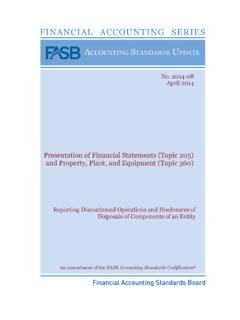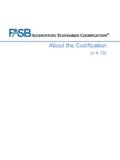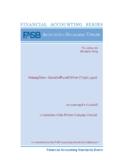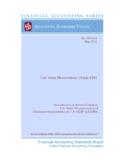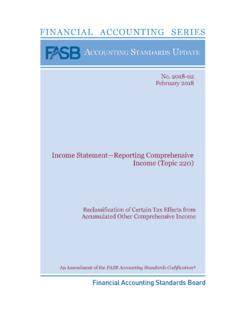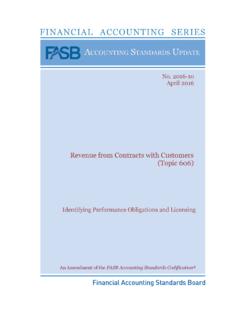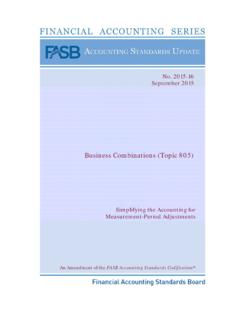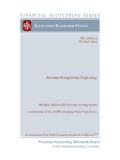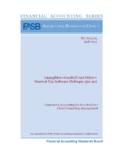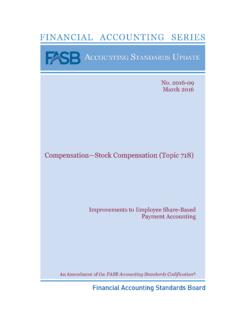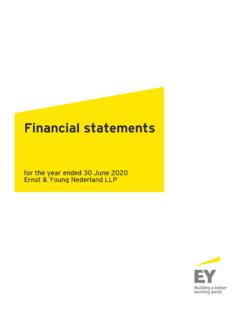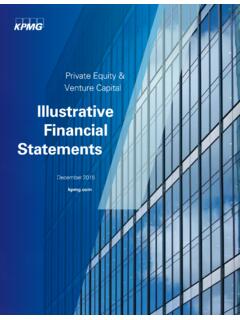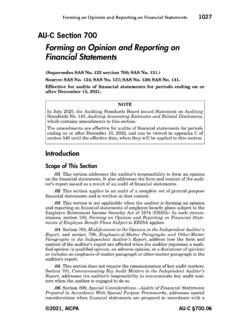Transcription of Not-for-Profit Entities (Topic 958)
1 Not-for-Profit Entities (Topic 958) No. 2016-14 August 2016 Presentation of financial Statements of Not-for-Profit Entities An Amendment of the FASB Accounting Standards Codification The FASB Accounting Standards Codification is the source of authoritative generally accepted accounting principles (GAAP) recognized by the FASB to be applied by nongovernmental Entities . An Accounting Standards Update is not authoritative; rather, it is a document that communicates how the Accounting Standards Codification is being amended. It also provides other information to help a user of GAAP understand how and why GAAP is changing and when the changes will be effective. For additional copies of this Accounting Standards Update and information on applicable prices and discount rates contact: Order Department financial Accounting Standards Board 401 Merritt 7 PO Box 5116 Norwalk, CT 06856-5116 Please ask for our Product Code No.
2 ASU2016-14. financial ACCOUNTING SERIES (ISSN 0885-9051) is published monthly with the exception of January, August, and October by the financial Accounting Foundation, 401 Merritt 7, PO Box 5116, Norwalk, CT 06856-5116. Periodicals postage paid at Norwalk, CT and at additional mailing offices. The full subscription rate is $255 per year. POSTMASTER: Send address changes to financial Accounting Standards Board, 401 Merritt 7, PO Box 5116, Norwalk, CT 06856-5116. | No. 438 Copyright 2016 by financial Accounting Foundation. All rights reserved. Content copyrighted by financial Accounting Foundation may not be reproduced, stored in a retrieval system, or transmitted, in any form or by any means, electronic, mechanical, photocopying, recording, or otherwise, without the prior written permission of the financial Accounting Foundation. financial Accounting Foundation claims no copyright in any portion hereof that constitutes a work of the United States Government.
3 An Amendment of the FASB Accounting Standards Codification No. 2016-14 August 2016 Not-for-Profit Entities (Topic 958) Presentation of financial Statements of Not-for-Profit Entities Accounting Standards UpdateFinancial Accounting Standards Board Accounting Standards Update 2016-14 Not-for-Profit Entities (Topic 958) Presentation of financial Statements of Not-for-Profit Entities August 2016 CONTENTS Page Numbers Summary .. 1 6 Amendments to the FASB Accounting Standards Codification .. 7 233 Background Information and Basis for Conclusions .. 234 263 Amendments to the XBRL Taxonomy .. 264 1 Summary Why Is the FASB Issuing This Accounting Standards Update (Update)? The FASB added a project to its agenda to improve the current net asset classification requirements and the information presented in financial statements and notes about a Not-for-Profit entity s (NFP s) liquidity, financial performance, and cash flows.
4 The FASB s Not-for-Profit Advisory Committee (NAC) and other stakeholders indicated that existing standards for financial statements of NFPs are sound but could be improved to provide more useful information to donors, grantors, creditors, and other users of financial statements. This Update is the result of the FASB s efforts in the first of two phases of its project. The amendments in this Update make certain improvements that address many, but not all, of the identified issues about the current financial reporting for NFPs. A second phase of the project is expected to address more protracted issues surrounding whether and how to define the term operations and align measures of operations (or financial performance) as presented in a statement of activities with measures of operations in a statement of cash flows. That will allow the Board to coordinate its Phase 2 considerations for NFPs with related research activities on financial performance reporting by business Entities .
5 This Update makes several improvements to current reporting requirements that address, among others, the following problems: 1. Complexities about the use of the currently required three classes of net assets that focus on the absence or presence of donor-imposed restrictions and whether those restrictions are temporary or permanent 2. Deficiencies in the transparency and utility of information useful in assessing an entity s liquidity caused by potential misunderstandings and confusion about the term unrestricted net assets and how restrictions or limits imposed by donors, grantors, laws, contracts, and governing boards affect an entity s liquidity, classes of net assets, and financial performance 3. Inconsistencies in the type of information provided about expenses of the period for example, some, but not all, NFPs provide information about expenses by both nature and function 4.
6 Impediment of preparing the indirect method reconciliation if an NFP chooses to use the direct method of presenting operating cash flows. 2 Who Is Affected by the Amendments in This Update? The amendments in this Update affect NFPs and the users of their general-purpose financial statements. NFPs generally receive significant contributed resources and operate to further a public purpose rather than to achieve a profit objective, and their stakeholders, unlike those of business Entities , generally do not have ownership interests. Those NFPs typically include nongovernmental Entities such as charities, foundations, colleges and universities, health care providers, cultural institutions, religious organizations, and trade associations, among others. They generally do not include investor-owned Entities or Entities that provide dividends, lower costs, or other economic benefits directly and proportionately to their owners, members, or participants, such as mutual insurance Entities , credit unions, farm and rural electric cooperatives, and employee benefit plans.
7 Rather, NFPs seek resources from lenders, bondholders, donors, and grantors, including foundations and governmental agencies, that seek financial information in making their decisions to lend, donate, or grant resources to an NFP. What Are the Main Provisions? The main provisions of this Update, which amend the requirements for financial statements and notes in Topic 958, Not-for-Profit Entities , require an NFP to: 1. Present on the face of the statement of financial position amounts for two classes of net assets at the end of the period, rather than for the currently required three classes. That is, an NFP will report amounts for net assets with donor restrictions and net assets without donor restrictions, as well as the currently required amount for total net assets. 2. Present on the face of the statement of activities the amount of the change in each of the two classes of net assets (noted in item 1) rather than that of the currently required three classes.
8 An NFP would continue to report the currently required amount of the change in total net assets for the period. 3. Continue to present on the face of the statement of cash flows the net amount for operating cash flows using either the direct or indirect method of reporting but no longer require the presentation or disclosure of the indirect method (reconciliation) if using the direct method. 4. Provide the following enhanced disclosures about: a. Amounts and purposes of governing board designations, appropriations, and similar actions that result in self-imposed limits on the use of resources without donor-imposed restrictions as of the end of the period. b. Composition of net assets with donor restrictions at the end of the period and how the restrictions affect the use of resources. 3 c. Qualitative information that communicates how an NFP manages its liquid resources available to meet cash needs for general expenditures within one year of the balance sheet date.
9 D. Quantitative information, either on the face of the balance sheet or in the notes, and additional qualitative information in the notes as necessary, that communicates the availability of an NFP s financial assets at the balance sheet date to meet cash needs for general expenditures within one year of the balance sheet date. Availability of a financial asset may be affected by (1) its nature, (2) external limits imposed by donors, grantors, laws, and contracts with others, and (3) internal limits imposed by governing board decisions. e. Amounts of expenses by both their natural classification and their functional classification. That analysis of expenses is to be provided in one location, which could be on the face of the statement of activities, as a separate statement, or in notes to financial statements. f. Method(s) used to allocate costs among program and support functions.
10 G. Underwater endowment funds, which include required disclosures of (1) an NFP s policy, and any actions taken during the period, concerning appropriation from underwater endowment funds, (2) the aggregate fair value of such funds, (3) the aggregate of the original gift amounts (or level required by donor or law) to be maintained, and (4) the aggregate amount by which funds are underwater (deficiencies), which are to be classified as part of net assets with donor restrictions. 5. Report investment return net of external and direct internal investment expenses and no longer require disclosure of those netted expenses. 6. Use, in the absence of explicit donor stipulations, the placed-in-service approach for reporting expirations of restrictions on gifts of cash or other assets to be used to acquire or construct a long-lived asset and reclassify any amounts from net assets with donor restrictions to net assets without donor restrictions for such long-lived assets that have been placed in service as of the beginning of the period of adoption (thus eliminating the current option to release the donor-imposed restriction over the estimated useful life of the acquired asset).
